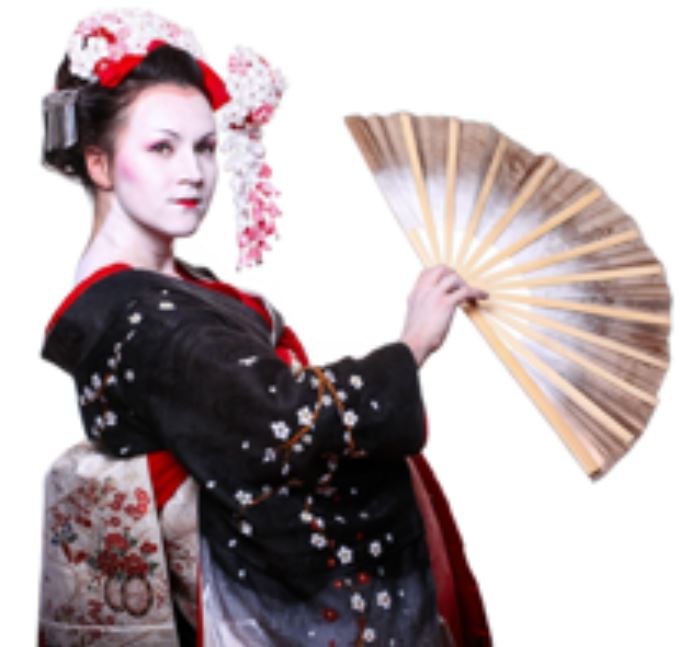Recent posts in the Book Art Theory blog have raised questions regarding equity, gatekeeping, accessibility, and inclusivity in the book arts. In keeping with this important and necessary line of inquiry, we want to talk about cultural appropriation in the book arts, specifically the appropriation of Asian imagery, aesthetics, design, materials, traditions, techniques, and language. This is an occurrence that is found all over the art world, not just in the book arts, and not just with Asian cultures. But as we are three Asian book artists, it is what we know and can speak to.

Image description: a person presenting as a white woman, wearing white makeup, black kimono, and floral hair piece, and holding a fan. Free image on Shutterstock.
Some instances of cultural appropriation that we have noticed: The use of random Asian words or characters to make something seem more "exotic" or have "Asian flair." Random references to Zen and/or Buddhism. Indian symbology like Om or meditating Buddha, prayer flags, or the arbitrary use of Asian calligraphy to create symbols. The "clever" use of chopsticks or bamboo in typography (this is not only culturally offensive, it is tacky). The erroneous use of the word "rice paper" to refer to Japanese, Korean, Chinese, Vietnamese paper when there is no rice in the paper. Not to mention that using the term “rice paper” to conflate all of these different Asian cultures perpetuates a view that Asian culture is a monolith, which further strips Asians of their individuality.
We have no problem with cultural appreciation and collaboration, where there is a deep respect and intentional effort to learn directly from the source. We admire non-Asian book/paper artists who have spent significant time in Asian countries, learning the language and/or working directly with master artists, deeply investing time and money to humbly learn an art form that is not of their own heritage. Institutions like the Fulbright Program encourage and support this kind of thoughtful cultural exchange. We appreciate when these non-BIPOC artists have an awareness of their immense privilege, to have the resources to travel to previously colonized countries and extract cultural knowledge, and the subtle and not-so-subtle ways that they might receive special treatment for being white.
When elements of Asian culture are cherry picked and used in a way that feels exploitative, disrespectful, or tacky, this feels less like collaboration and more like appropriation. When the maker has no apparent connection or desire to deepen their understanding not only of the culture from whom they borrowed, but also of the people who carry the heritage – this feels like appropriation. And when non-BIPOC folks have a savior complex about the cultural knowledge that they are “rescuing” – this is not cultural exchange, this is colonization and appropriation. Even institutions that purport to encourage cultural exchange (such as the aforementioned Fulbright Program) can perpetuate this harmful practice of white saviorism – for instance, so many white Americans come to India to “discover” natural dyes, classical music, or other pieces of Indian culture, and then lecture about it while in India, to an Indian public. It is also problematic when we see that the instructors or cultural practitioners in North America/Europe are almost exclusively white, rather than those with lived experiences and cultural ties, such as immigrants.
As artists, it is important to recognize the historical precedent for people from the dominant culture taking elements from marginalized people's cultures and using them for their own profit without consent, without acknowledgment of histories of oppression, colonization, imperialism, erasure, and violence. As educator Emi Ito states, "cultural appropriation has always been part of propping up the violence of white supremacy."
Borrowing from other cultures is often necessary in our field, and artists find inspiration from all kinds of sources. As book artists, we pride ourselves in our versatility and ability to draw from so many disciplines and traditions to create a bookwork. As our field is relatively new, we can only benefit and grow stronger as a field when we start to ask ourselves critical questions about how or why we make or use certain cultural elements in our work.
This blog post is in two parts. In Part 2, we offer some guidelines for non-BIPOC book and paper artists to think about and reconsider cultural appropriations in their work.
Steph Rue is an artist and papermaker based in Sacramento, CA. She received her MFA at the University of Iowa Center for the Book, and studied traditional book and papermaking on a Fulbright to Korea in 2015. Steph is co-founder of the Korean American Artist Collective and co-founder of Hanji Edition.
Radha Pandey is a papermaker and letterpress printer based in Norway/India. She earned her MFA at the University of Iowa Center for the Book, and specializes in Indo-Islamic Papermaking techniques, teaching classes in India, Europe and the US. Her artist's books are held in over 90 public collections internationally.
Catherine Liu received a Master of Fine Arts in Book Arts at the University of Iowa Center for the Book in 2019. To further their knowledge in natural dyes they received multiple University of Iowa Graduate Fellowships, a Stanley Award for International Research, and a Fulbright research grant to study dyeing, printing, papermaking practices in China and Japan.
This post was moderated by Kathy Walkup

